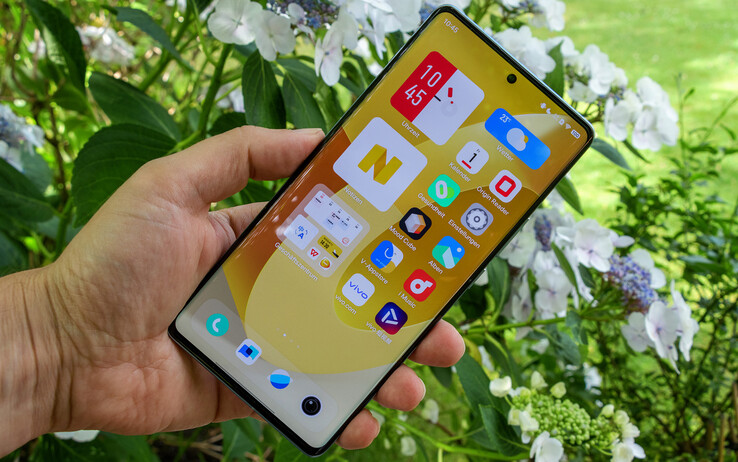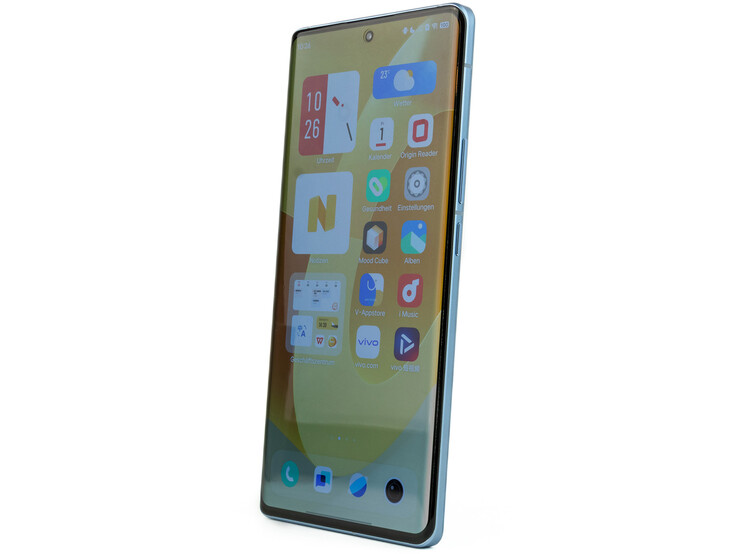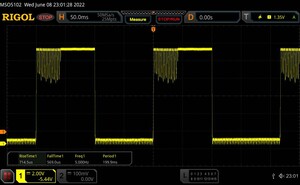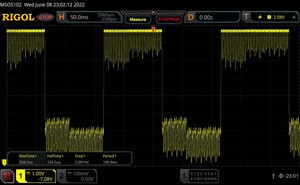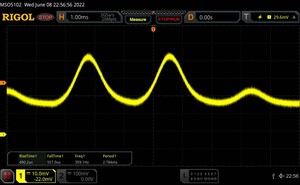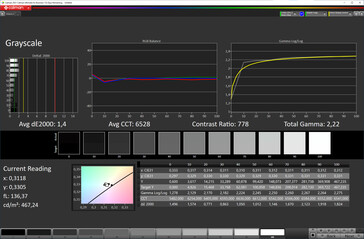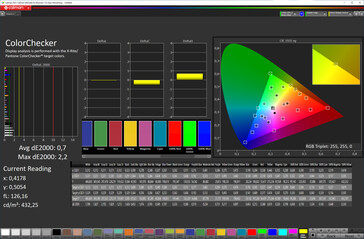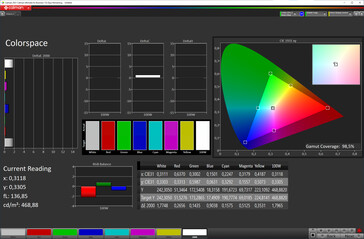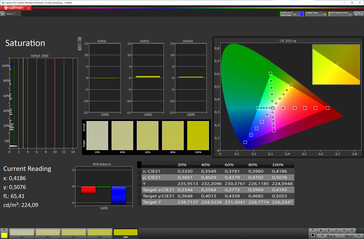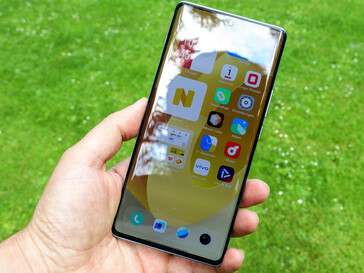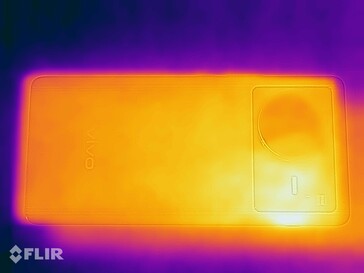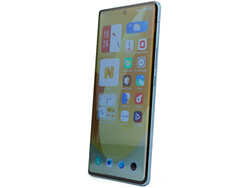Vivo X Note Review: Giant smartphone with all the zips and zaps
Possible competitors in comparison
Rating | Date | Model | Weight | Drive | Size | Resolution | Price |
|---|---|---|---|---|---|---|---|
| 87.5 % v7 (old) | 07 / 2022 | Vivo X Note SD 8 Gen 1, Adreno 730 | 221 g | 512 GB UFS 3.1 Flash | 7.00" | 3080x1440 | |
| 89.4 % v7 (old) | 03 / 2022 | Samsung Galaxy S22 Ultra 5G Exynos 2200, Xclipse 920 | 228 g | 128 GB UFS 3.1 Flash | 6.80" | 3088x1440 | |
| 89.2 % v7 (old) | 04 / 2022 | Oppo Find X5 Pro SD 8 Gen 1, Adreno 730 | 221 g | 256 GB UFS 3.1 Flash | 6.70" | 3216x1440 | |
| 87.6 % v7 (old) | 02 / 2022 | Xiaomi 12 Pro SD 8 Gen 1, Adreno 730 | 204 g | 256 GB UFS 3.1 Flash | 6.73" | 3200x1440 |
Case and equipment: Vivo X Note with USB 3.2 and IR blaster
The Vivo X Note looks really big, but it is lighter than expected at 221 g and features a 5,000 mAh battery. It is certainly not a lightweight device, though. Our blue test model has a matte aluminum frame and a leather-like back texture. It looks quite chic and offers a good grip that is insensitive to fingerprints. Black and a gray versions are also available.
The workmanship is very good. Tight and even gaps with high torsional stiffness characterize the Vivo X Note smartphone. However, there is some audible crackling that is perceivable when the smartphone is bent back and forth a bit. The casing is protected against dust and water ingress thanks to the IP68 rating.
The features hardly leave anything to be desired. The USB 3.2 port not only allows fast data transfers and OTG but also wired image output. The display content, however, is only mirrored on the external display, which does not work very smoothly. In addition, there is an IR blaster for controlling multimedia devices, cameras, and air conditioners. The lack of memory expansion can certainly be coped with due to the huge internal memory. A physical mute button is also located on the left long side.
Communication, software and operation: Everything in it, but no Wi-Fi 6E
The Vivo X Note's communication equipment is largely full-fledged. The Wi-Fi module supports Wi-Fi 6 with VHT80, but it weakens slightly when sending data in combination with our reference Asus ROG Rapture AXE11000 router. However, this will not be noticed in everyday use since the transmission speed is still very high.
A wide range of frequencies is available for mobile Internet, which does not leave anything to be desired even though our test device is an import from China. This applies to both LTE and 5G. If a German SIM is inserted, the system complains that it is not from "mainland China" and that there might be restrictions with 5G. We could not determine these. The smartphone connected to the 5G network without problems in the test and the transmission rates were also on the expected level.
The telephony features are convincing too. VoLTE and Wi-Fi calls are supported. The Vivo X Note also accommodates two nano-SIM cards. When held to the ear, the X Note delivers a good voice quality and also suppresses most ambient noise; it reverberates a bit in speaker mode. Phone calls can also be recorded directly via the call app.
The operating system is Android 12, which is covered by Vivo's own Origin OS. The security patches were up to date on June 1, 2022, at the time of the review. However, it is not clear as to how long the Vivo X Note will be supported with updates. Although it is an imported device, German can also be selected as the system language. The translation is a bit bumpy in some places but is largely successful.
The capacitive touchscreen of the Vivo X Note works very reliably in all areas and implements inputs precisely. A matching screen protector is already applied ex-factory, which offers decent gliding properties.
Biometric security is ensured by a large 3D ultrasonic fingerprint sensor. Setup is lightning fast with just one touch and is very reliable. The recognition area is much larger than conventional smartphones. Individual apps can even be protected with two-finger authentication, in which case two different fingers are checked by the sensor at the same time. In addition, facial recognition via the front-facing camera can also be used.
| Networking | |
| Vivo X Note | |
| iperf3 transmit AXE11000 | |
| iperf3 receive AXE11000 | |
| Samsung Galaxy S22 Ultra 5G | |
| iperf3 transmit AXE11000 | |
| iperf3 receive AXE11000 | |
| iperf3 transmit AXE11000 6GHz | |
| iperf3 receive AXE11000 6GHz | |
| Oppo Find X5 Pro | |
| iperf3 transmit AXE11000 | |
| iperf3 receive AXE11000 | |
| Xiaomi 12 Pro | |
| iperf3 transmit AXE11000 | |
| iperf3 receive AXE11000 | |
Cameras: Quad optics in the Vivo X Note
The Vivo X Note takes impressive selfies. A wide range of filters and a beauty mode can be used for this. However, the front-facing camera only records videos in Full HD 30 fps.
The quad camera on the back offers a wide range of applications. Besides the 50 MP main sensor, an ultra-wide-angle, and two zoom lenses are installed. Vivo calls the 2x optical magnification a portrait lens, and the periscope camera even allows a 5x optical magnification. Digitally, a 60x zoom is possible. The pictures have a respectable dynamic range and present themselves with high contrasts. Only in low light do quite a few details get lost. Furthermore, slight aberrations can be seen at the ultra-wide angle.
Videos can be recorded in 8K, but stabilization will not be available in this mode. The situation is different up to Ultra HD 60 fps, and those who are satisfied with Full HD 30 fps can make use of an even more powerful Ultra and 360-degree stabilization.
Image comparison
Choose a scene and navigate within the first image. One click changes the position on touchscreens. One click on the zoomed-in image opens the original in a new window. The first image shows the scaled photograph of the test device.
HauptkameraHauptkameraUltraweitwinkel5-facher ZoomLow-Light

Display: Super bright LTPO AMOLED with up to 120 Hz
The 7.0-inch LTPO OLED panel of the Vivo X Note works with a QHD+ resolution, which can also be reduced. The refresh rate can be adjusted automatically by the system and works between 1 and 120 Hz. A fixed 60 Hz or 120 Hz refresh rate can be set manually.
The brightness is very high with the ambient light sensor enabled and even reaches a peak of 1,360 cd/m² in the APL18 measurement. Those who prefer to adjust the brightness manually have 497 cd/m² at their disposal.
Like most OLEDs, the Vivo smartphone's also flickers. We measured a frequency between 182.3 Hz and 359.1 Hz in minimum display brightness. Although a DC dimming mode can be enabled via the developer options, it does not show any effect in a control measurement. Thus, users sensitive to PWM may experience some inconvenience due to prolonged viewing.
| |||||||||||||||||||||||||
Brightness Distribution: 96 %
Center on Battery: 997 cd/m²
Contrast: ∞:1 (Black: 0 cd/m²)
ΔE ColorChecker Calman: 0.7 | ∀{0.5-29.43 Ø4.78}
ΔE Greyscale Calman: 1.4 | ∀{0.09-98 Ø5}
98.5% sRGB (Calman 2D)
Gamma: 2.22
CCT: 6528 K
| Vivo X Note AMOLED, 3080x1440, 7" | Samsung Galaxy S22 Ultra 5G Dynamic AMOLED, 3088x1440, 6.8" | Oppo Find X5 Pro AMOLED, 3216x1440, 6.7" | Xiaomi 12 Pro AMOLED, 3200x1440, 6.7" | |
|---|---|---|---|---|
| Response Times | 2% | 13% | -325% | |
| Response Time Grey 50% / Grey 80% * (ms) | 1.09 ? | 0.872 ? 20% | 0.711 ? 35% | 7.2 ? -561% |
| Response Time Black / White * (ms) | 1.28 ? | 1.501 ? -17% | 1.389 ? -9% | 2.4 ? -88% |
| PWM Frequency (Hz) | 359.1 | 120 | 361 | 367.6 |
| Screen | -6% | -11% | -24% | |
| Brightness middle (cd/m²) | 997 | 1077 8% | 746 -25% | 959 -4% |
| Brightness (cd/m²) | 1005 | 1093 9% | 744 -26% | 977 -3% |
| Brightness Distribution (%) | 96 | 97 1% | 97 1% | 96 0% |
| Black Level * (cd/m²) | ||||
| Colorchecker dE 2000 * | 0.7 | 1.2 -71% | 0.9 -29% | 1.1 -57% |
| Colorchecker dE 2000 max. * | 2.2 | 2 9% | 1.6 27% | 3.1 -41% |
| Greyscale dE 2000 * | 1.4 | 1.3 7% | 1.6 -14% | 1.9 -36% |
| Gamma | 2.22 99% | 2.37 93% | 2.23 99% | 2.22 99% |
| CCT | 6528 100% | 6526 100% | 6499 100% | 6498 100% |
| Total Average (Program / Settings) | -2% /
-4% | 1% /
-5% | -175% /
-99% |
* ... smaller is better
Display Response Times
| ↔ Response Time Black to White | ||
|---|---|---|
| 1.28 ms ... rise ↗ and fall ↘ combined | ↗ 0.7145 ms rise | |
| ↘ 0.569 ms fall | ||
| The screen shows very fast response rates in our tests and should be very well suited for fast-paced gaming. In comparison, all tested devices range from 0.1 (minimum) to 240 (maximum) ms. » 6 % of all devices are better. This means that the measured response time is better than the average of all tested devices (20.2 ms). | ||
| ↔ Response Time 50% Grey to 80% Grey | ||
| 1.09 ms ... rise ↗ and fall ↘ combined | ↗ 0.5585 ms rise | |
| ↘ 0.5345 ms fall | ||
| The screen shows very fast response rates in our tests and should be very well suited for fast-paced gaming. In comparison, all tested devices range from 0.165 (minimum) to 636 (maximum) ms. » 4 % of all devices are better. This means that the measured response time is better than the average of all tested devices (31.6 ms). | ||
Screen Flickering / PWM (Pulse-Width Modulation)
| Screen flickering / PWM detected | 359.1 Hz | ||
The display backlight flickers at 359.1 Hz (worst case, e.g., utilizing PWM) . The frequency of 359.1 Hz is relatively high, so most users sensitive to PWM should not notice any flickering. However, there are reports that some users are still sensitive to PWM at 500 Hz and above, so be aware. In comparison: 53 % of all tested devices do not use PWM to dim the display. If PWM was detected, an average of 8111 (minimum: 5 - maximum: 343500) Hz was measured. | |||
Measurement series with fixed zoom level and different brightness settings
Performance, emissions and battery life
The Vivo X Note is powered by a Snapdragon 8 Gen 1 with 12 GB LPDDR5 working memory. Graphics calculations are handled by the integrated Adreno 730. Thus, the smartphone relies on a cutting-edge and powerful platform, which is also ideally suited for gaming.
The Vivo smartphone delivers well in the benchmarks and positions itself in the expected range. The installed cooling solution is also comparatively good because the X Note achieves higher frame rates than other rivals in long-term performance and does not throttle the SoC as much. Despite all that, it does not even get warm to the touch.
The two speakers can be very powerful, but they are not optimally tuned. The sound is quite appealing in the medium volume range, although the low and super-high tones are somewhat lacking. This can be reflected negatively especially in the latter. The sound can be output via USB-C and Bluetooth — most important audio codecs (SBC, AAC, aptX, aptX HD, LDAC) are available wirelessly.
In terms of battery runtimes, the Vivo X Note is just at the top of the comparison field with its 5,000 mAh battery. With a runtime of over 14 hours, there should be enough power for a day. Otherwise, the smartphone can be recharged quickly with the included 80 W charger.
| GFXBench | |
| on screen Aztec Ruins Normal Tier Onscreen (sort by value) | |
| Vivo X Note | |
| Samsung Galaxy S22 Ultra 5G | |
| Oppo Find X5 Pro | |
| Xiaomi 12 Pro | |
| Average Qualcomm Snapdragon 8 Gen 1 (38 - 98, n=20) | |
| Average of class Smartphone (6.2 - 166, n=211, last 2 years) | |
| 1920x1080 Aztec Ruins Normal Tier Offscreen (sort by value) | |
| Vivo X Note | |
| Samsung Galaxy S22 Ultra 5G | |
| Oppo Find X5 Pro | |
| Xiaomi 12 Pro | |
| Average Qualcomm Snapdragon 8 Gen 1 (60 - 131, n=22) | |
| Average of class Smartphone (3.4 - 367, n=211, last 2 years) | |
| on screen Aztec Ruins High Tier Onscreen (sort by value) | |
| Vivo X Note | |
| Samsung Galaxy S22 Ultra 5G | |
| Oppo Find X5 Pro | |
| Xiaomi 12 Pro | |
| Average Qualcomm Snapdragon 8 Gen 1 (27 - 69, n=20) | |
| Average of class Smartphone (0.85 - 144, n=212, last 2 years) | |
| 2560x1440 Aztec Ruins High Tier Offscreen (sort by value) | |
| Vivo X Note | |
| Samsung Galaxy S22 Ultra 5G | |
| Oppo Find X5 Pro | |
| Xiaomi 12 Pro | |
| Average Qualcomm Snapdragon 8 Gen 1 (19 - 49, n=22) | |
| Average of class Smartphone (1.2 - 129, n=211, last 2 years) | |
| Vivo X Note | Samsung Galaxy S22 Ultra 5G | Oppo Find X5 Pro | Xiaomi 12 Pro | Average 512 GB UFS 3.1 Flash | Average of class Smartphone | |
|---|---|---|---|---|---|---|
| AndroBench 3-5 | -13% | -35% | 6% | -3% | 10% | |
| Sequential Read 256KB (MB/s) | 1873.54 | 1653 -12% | 1410 -25% | 1620 -14% | 1872 ? 0% | 2223 ? 19% |
| Sequential Write 256KB (MB/s) | 1439.88 | 1074 -25% | 894 -38% | 1465 2% | 1324 ? -8% | 1838 ? 28% |
| Random Read 4KB (MB/s) | 292.73 | 322.3 10% | 183.7 -37% | 324.9 11% | 288 ? -2% | 295 ? 1% |
| Random Write 4KB (MB/s) | 358.43 | 273.1 -24% | 210.4 -41% | 448.9 25% | 355 ? -1% | 335 ? -7% |
Temperature
(+) The maximum temperature on the upper side is 33.9 °C / 93 F, compared to the average of 35.2 °C / 95 F, ranging from 21.9 to 247 °C for the class Smartphone.
(+) The bottom heats up to a maximum of 33.3 °C / 92 F, compared to the average of 34 °C / 93 F
(+) In idle usage, the average temperature for the upper side is 28.6 °C / 83 F, compared to the device average of 32.9 °C / 91 F.
Loudspeaker
Vivo X Note audio analysis
(+) | speakers can play relatively loud (90 dB)
Bass 100 - 315 Hz
(-) | nearly no bass - on average 22.6% lower than median
(±) | linearity of bass is average (8.6% delta to prev. frequency)
Mids 400 - 2000 Hz
(+) | balanced mids - only 4.3% away from median
(+) | mids are linear (4.4% delta to prev. frequency)
Highs 2 - 16 kHz
(±) | higher highs - on average 7.1% higher than median
(+) | highs are linear (5.6% delta to prev. frequency)
Overall 100 - 16.000 Hz
(±) | linearity of overall sound is average (18.8% difference to median)
Compared to same class
» 22% of all tested devices in this class were better, 10% similar, 68% worse
» The best had a delta of 11%, average was 35%, worst was 134%
Compared to all devices tested
» 42% of all tested devices were better, 8% similar, 50% worse
» The best had a delta of 4%, average was 24%, worst was 134%
Xiaomi 12 Pro audio analysis
(+) | speakers can play relatively loud (84.2 dB)
Bass 100 - 315 Hz
(-) | nearly no bass - on average 18.8% lower than median
(±) | linearity of bass is average (12.9% delta to prev. frequency)
Mids 400 - 2000 Hz
(+) | balanced mids - only 4.2% away from median
(+) | mids are linear (4.4% delta to prev. frequency)
Highs 2 - 16 kHz
(+) | balanced highs - only 3.1% away from median
(+) | highs are linear (6.8% delta to prev. frequency)
Overall 100 - 16.000 Hz
(+) | overall sound is linear (14.8% difference to median)
Compared to same class
» 2% of all tested devices in this class were better, 2% similar, 96% worse
» The best had a delta of 11%, average was 35%, worst was 134%
Compared to all devices tested
» 19% of all tested devices were better, 4% similar, 77% worse
» The best had a delta of 4%, average was 24%, worst was 134%
Battery life
| Battery Runtime - WiFi Websurfing | |
| Average of class Smartphone (12.1 - 54.1, n=211, last 2 years) | |
| Vivo X Note | |
| Samsung Galaxy S22 Ultra 5G | |
| Oppo Find X5 Pro | |
| Xiaomi 12 Pro | |
Pros
Cons
Verdict - Strong flagship smartphone with few weaknesses
The Vivo X Note is a strong high-end smartphone that has much more to offer than just a large screen. We especially liked the screen in the test because it is very bright, can work between 1 and 120 Hz, has an enormously high pixel density, and offers an accurate color reproduction.
Additionally, the Vivo smartphone also offers almost everything else that we would want from such a flagship-class device. The storage is ample, all current mobile standards are supported, wireless charging, IP certification, and a versatile camera are on board.
The Vivo X Note is a powerful high-end smartphone with many advantages
A very good rating is ultimately prevented due to the B grade in the camera. The setup is really strong in daylight but rather mediocre in low-light. Furthermore, many features are only available in Full HD in video mode. The uncertain update supply is also a factor that should be considered in this price range.
Alternatives usually cost more money in this country, but the Galaxy S22 Ultra, Honor Magic4 Pro or Oppo Find X5 Pro are worth mentioning at this point. In a similar price range, the Pixel 6 Pro can be an enticing prospect.
Price and availability
The Vivo X Note is only available in Europe as a direct import from China from our loaner TradingShenzhen, for example.
Vivo X Note
- 08/30/2022 v7 (old)
Daniel Schmidt




